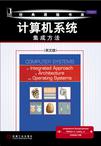计算机系统
出版时间:2010-12 出版社:机械工业出版社 作者:(美)Umakishore Ramachandran,William D. Leahy, Jr. 页数:741
Tag标签:无
前言
here is excitement when you talk to high school students about computers.There is a sense of mystery as to what is“inside the box”that makes the computer do such things as play video games with cool graphics.play music—_be it rap or symphony——send instant messages to friends,and so on.The purpose behind this textbook is to take the 10umey together to discover the mystery ofwhat is inside the box As a glimpse ofwhat is to come,let us say at the outset that what makes the box interesting is not 1USt the hardware,but also how the hardware and the system software work in tandem to make it a11 happen Therefore.the path we take in this book is to look at hardware and software together to see how one helps the other and how together they make the box interesting and useful We caU this approach“unraveling the box”一that is.resolving the mysteIT of what is in—side the box:We look inside the box and understand how to design the key hardware el—ements(processor,memory,and peripheral controllers)and the OS abstractions neededto manage all the hardware resources inside a computer,including processor,memory,I/0 and disk,multiple processors,and network.Hence,this is a textbook for a first course in computer systems embodying a novel integrated approach to these topics.
内容概要
本书采用集成方法,系统地讲解了计算机系统的软件和硬件知识。全书分为5个模块:处理器、内存系统、存储系统、并行系统和网络,分别介绍并讨论了处理器及其相关的软件问题、内存系统和内存分级体系、I/O和文件系统、操作系统问题及支持并行编程的多处理器中相应体系结构特点、网络硬件的发展和处理各种网络行为的网络协议堆的特点等。通过本书,读者将洞悉计算机软件和硬件之间的相互作用,加深对现代操作系统的理解。
作者简介
作者:(美国)拉姆阿堪德兰(Umakishore Ramachandran) (美国)利海(William D.Leahy.Jr.)Umakishore Ramachandran,1986年获得威斯康星大学麦迪逊分校计算机科学专业博士学位.现在是佐治亚理工学院计算机系教授,STAR Center&Korean Programs中心主任.其主要研究兴趣是体系结构设计、程序设计和并行分布式系统分析。他曾获得NSF授予的美国总统青年科学家奖、佐治亚理工学院优秀博士论文指导奖等。William D.Leahy,Jr.现为佐治亚理工学院计算机系讲师。
书籍目录
PrefaceChapter 1 IntroductionChapter 2 Processor ArchitectureChapter 3 Processor ImplementationChapter 4 Interrupts,Traps,and ExceptionsChapter 5 Processor Performance and Pipelined Processor DesignChapter 6 Processor SchedulingChapter 7 Memory Management TechniquesChapter 8 Details of Page-Based Memory ManagementChapter 9 Memory HierarchyChapter 10 Input/Output and Stable StorageChapter 11 File SystemChapter 12 Multithreaded Programmin and MultiprocessorsChapter 13 Fundamentals of Networking and Network ProtocolsChapter 14 Epilogue:A Look Back at the Journey
章节摘录
插图:Applications have in the past influenced, and continue to date to influence, the designof instruction set. In the 1970s, and perhaps into the 1980s, computers were used pri-marily for number crunching in scientific and engineering applications. Such applica-tions rely heavily on floating-point arithmetic. Whereas high-end computers (such asIBM 370 series and Cray) included such instructions in their ISA, the so-calledminicomputers of that era (such as DEC PDP 11 series) did not. There were successfulcompanies (e.g., Floating Point Systems, Inc.) that made attached processors for acceler-ating floating-point arithmetic for the minicomputers. Nowadays, floating-pointinstructions are a part of any general-purpose processor. Processors (e.g., StrongARM,ARM) that are used in embedded applications such as cell phones and PDAs may nothave such instructions. Instead, they realize the effect of floating-point arithmetic byinteger instructions for supporting math libraries.Another example of applications' influence on the ISA is the MMX instructionsfrom Intel. Applications that process audio, video, and graphics deal with streamingdata——that is, continuous data such as a movie or music. Such data would be repre-sented as arrays in the memory. The MMX instructions, first introduced by Intel in 1997in their Pentium line of processors, aimed at dealing with streaming data efficiently bythe CPU. The intuition behind these instructions is pretty straightforward. As the namestream data suggests, audio, video, and graphics applications require the same operation(such as addition) to be applied to corresponding elements of two or more streams.Therefore, it makes sense to have instructions that mimic this behavior. The MMXinstructions originally introduced in the Pentium line and its successors do preciselythat. There are 57 instructions, grouped into categories such as arithmetic, logical, com-parison, conversion, shift, and data transfer, and each one takes two operands (each ofwhich is not a scalar, but a vector of elements).
编辑推荐
《计算机系统·集成方法(英文版)》特色:采用启发式教学方法,以问题驱动,激发读者的学习兴趣;逐步探索,揭开计算机系统的神秘面纱。以丰富的实例阐明相关概念及问题,加深读者对所学知识的理解。提供了丰富的历史背景知识。并就某些问题探讨了其未来发展趋势.便于读者融会贯通。每章末都给出了练习题和延伸阅读建议,帮助读者掌握所学知识。
图书封面
图书标签Tags
无
评论、评分、阅读与下载
用户评论 (总计1条)
- 目前这方面的书实在很多,但各有特点。《computer organization and design:the hardware/software interface》侧重于MIPS指令集与C语言接口,处理器设计和存储器层次结构。就我个人而言,我是看这本书学习计算机的,并且也为我的目标即理解计算机打下了基础。我的看书方法就是同一题材以一本书为主同时参阅多本同题材书,这样多本书翻下来,很容易抓住了“the big picture”,然后再解决细节问题。这对我这样的非计算机本科专业毕业者来学习计算机很有好处。《introduction to computer systems: from bits to c and beyond》侧重于LC-3指令集与C语言接口,而其后半部分更侧重于C语言编程,这可能是他们的第一门计算机课程,起点不俗。《computer systems: a programmer's perspective》可以说面面俱到:汇编语言与C语言接口,处理器设计,性能优化,连接,网络,线程,性能度量。可以说广度和深度都超越了前两本书,也为未来的计算机方向打下坚实基础。那么这本书而言,同样也是数字逻辑起,牵涉到硬件和软件的方方面面。甚至有的地方比上述三本书都要广一些,例如interleaved ...memory,本来在patterson&hennsey的《computer architecture: a quantitative approach》第二版涉及,这本书就有提到,我也是为了搞懂这个把图书馆所有这方面的书都翻了一遍。不过最终还是发现morgan kaufmann的一本书讲解最好,不过那本书也太专业了。我尝试着按自己理解改写自己的一个程序,性能从356s提高到329s,感觉理解还不透彻。这一圈看下来,感觉量化研究那本书果然很好,其实他们的作者主要是起到了总结作用,把大量的论文和书籍进行了提炼。这本书有很多图表,这样容易理解问题所在,我很喜欢这一点。 阅读更多 ›
